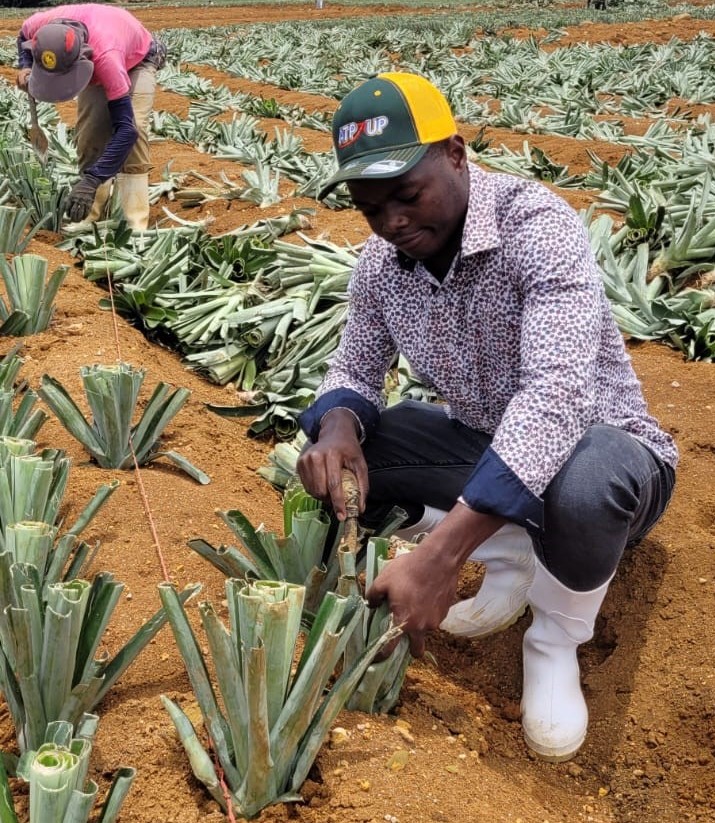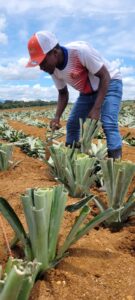Planting of Pineapple – Pineapple Plant Density

This post is also available in:
This post is also available in:
![]() Español (Spanish)
Español (Spanish) ![]() Français (French)
Français (French) ![]() Deutsch (German)
Deutsch (German) ![]() हिन्दी (Hindi)
हिन्दी (Hindi) ![]() العربية (Arabic)
العربية (Arabic) ![]() 简体中文 (Chinese (Simplified))
简体中文 (Chinese (Simplified)) ![]() Português (Portuguese (Brazil))
Português (Portuguese (Brazil))
Pineapples are propagated asexually, and their propagation materials can come from various parts of the plant. The most common parts that are used for propagation are slips, hapas, crowns, and suckers, which are obtained from a mother pineapple plant (1). The number of slips, hapas, and suckers a plant can give depends on its clone and the climate of the production area. The following are their distinguishing characteristics.
- Crowns: Are obtained from the top of the fruit. The disadvantage of crowns is that they usually have low fresh weight compared to slips and suckers, which are mostly 200 g (7 oz) or less. This results in more extended time to reach harvest time.
- Slips: Are obtained from the peduncle immediately beneath the fruit. These pieces usually have a rudimentary (vestigial) fruit or knob at their base.
- Hapas: Develop within the growth zone between the stem and the peduncle.
- Suckers: Emerge within some centimeters below the surface of the stem-peduncle growth zone. Suckers form on the lower part of the stem before the roots can grow into the ground and are called ground suckers. Suckers attain the appropriate weight that guarantees less time for flower induction as compared to slips or crowns, shortening the cycle from planting to harvest. It is also important to mention that suckers are the most common materials for propagation in the majority of commercial pineapple farms.

Plant distancing of suckers
Pineapple Planting system and Density

The planting distances usually depend on the environment (availability of water and average temperatures), the pineapple variety and type of propagation material used and the yield goals of the farmer. In general, pineapples can be planted in a density that varies from 31,000 to 75,000 trees per hectare (12,600-30,400 trees per acre). The lower planting densities are usually more suitable for fertile, hilly áreas with sufficient rainfalls, while the higher planting densities are more common in sub-tropical and mid-humid conditions (2).
Single-row and double-row planting methods are the two approaches that may be used for growing pineapples. The single-row method is not very effective, and low-density planting does not provide enough shade, increasing the risk of sunburn or drying of the fruits. It is advisable to use a double-row design because it maximizes profits and makes the best use of the available space while also decreasing weed infestations and protecting from sunburn.
In low-scale production, most planting is done by hand, in which case the traditional narrow-bladed hoe with a short handle is used. The handle, which is 12 inches (30 cm) long, is used to measure the distance between plants. It is important to note that the type of propagation material used will affect the planting depth, as shown below.
- Crowns are set at a depth of 2 inches (5 cm).
- Slips and suckers are set at a depth of 3 1/2 to 4 inches (9 to 10 cm).
The plantlets can be spaced 10-12 inches (25 to 30 cm) apart within the row and with 2 feet (60 cm) between the row (as shown in the photo below). It is recommended that between the pair-rows, there should be an alley that is 3 ft (0.9 m), 1.6 ft (1.8 m), or 6 ft (1.8 m) wide which allows plants to grow at a population of 15,900 plants on average per acre (38,140 plants on average per hectare)(3).
References
[1] Duane P. B., Kenneth G. R. & Dale O. E. (2002). Pineapple production in Hawaii. https://www.ctahr.hawaii.edu/oc/freepubs/pdf/f_n-7.pdf
[2] National Horticulture board. Monistry of Agriculture and farmers welfare Goverment of India. https://nhb.gov.in/report_files/pineapple/
[3] Morton, J. 1987. Pineapple In: Fruits of warm climates. p. 18–28. https://hort.purdue.edu/newcrop/morton/pineapple.html
Pineapple History, Uses and Nutritional Value
Pineapples Plant Information and Environmental Requirements
Soil Requirements and Land Preparation for Pineapple
Planting of Pineapple – Pineapple Plant Density
Pineapple Water Needs and Irrigation Systems
Pineapple Fertilization Requirements








































































